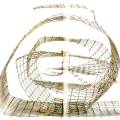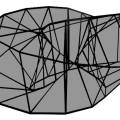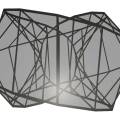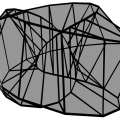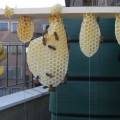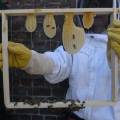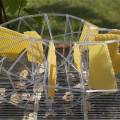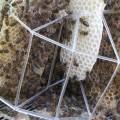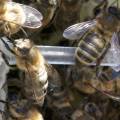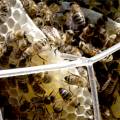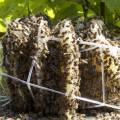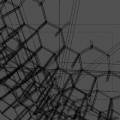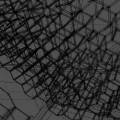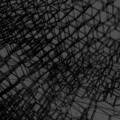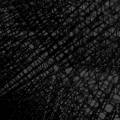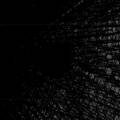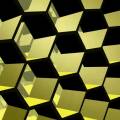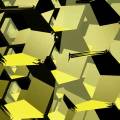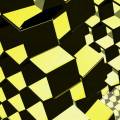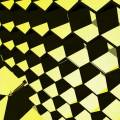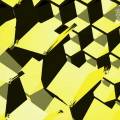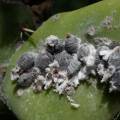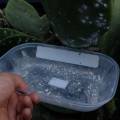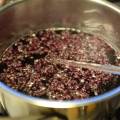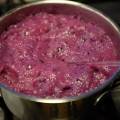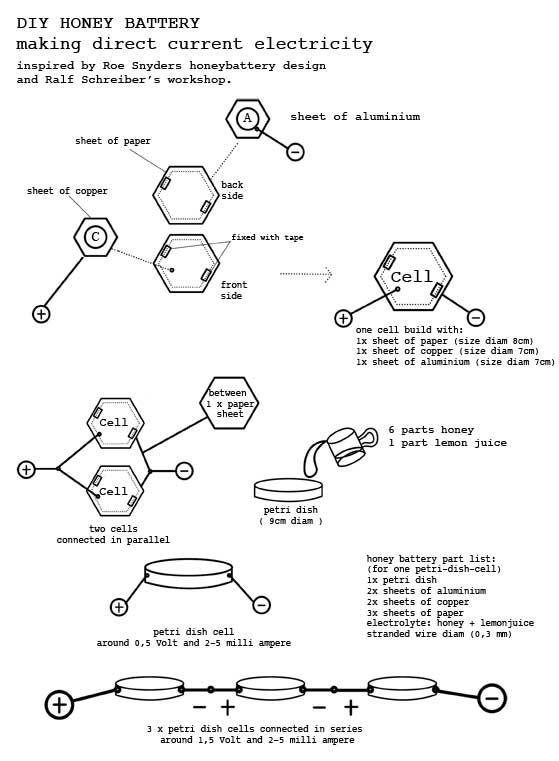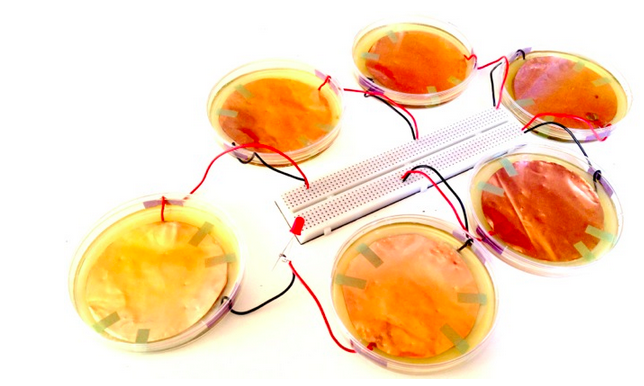Table of Contents
BEE MATERIAL
The artistic work of the Brussels Urban Bee Lab (BUBL) is already since more than five years based on a rigorous research into bees. This artistic laboratory installed beehives on garden roofs in the centre of Brussels. The artists and technicians of Brussels Urban Bee Lab designed sophisticated equipment to monitor and measure the bee colonies, process the data and disseminate these via streaming. This research so far instigated a series of installations, objects, graphic works, sound works and workshops that were shown in galleries, festivals and public spaces. It induced an intense interaction with scientists and technologists, partly to build and install the measuring equipment but also to investigate the reasons for the urgent problem of bee colonies starting to die out in all industrialised countries.
The Brussels Urban Bee Lab wants to continue and deepen this work that gets an ever-growing international response and to show it in artistic contexts. More specifically the research wants to use an artistic explorative method to investigate whether biomaterials from the hive (wax, propolis, honey, micro-organisms) can contribute to radical new ideas for future ‘intelligent’ beehives. Apart from artistic research that will lead to artistic formats of the outcomes that can be shown in exhibitions and other presentations, the audience will also be strongly involved via workshops.
Therefore, the Brussels Urban Bee Lab developed a format that throws open artistic research and contextualises it in an audience friendly way. The 3DPrint-project BEE MATERIAL continues to deepen the research of the Brussels Urban Bee Lab and is at the core of these art/science presentations where the technologically equipped observation beehives, the work processes and artefacts, the data analysis and visualisations but above all the artistic multimedia installations will be presented and explained from the point of view of different disciplines.
Bees can be seen as living 3D printers that reach an extreme grade of mathematical perfection when building a honeycomb. Through the centuries physics and mathematicians have wondered how a bee colony reaches this result. AnneMarie Maes and the Brussels Urban Bee Lab want to take up the challenge to work just as constructive with 3D printers and organic materials, as wax and propolis, to make objects together with the bees and inspired by the bees’ work.
The proposed artistic research will happen in collaboration with other artists, both members of the Brussels Urban Bee Lab/ OKNO as other international artists, and institutes and companies specialised in relevant technology and biology.
It is not the intention to perform purely technological research but rather to broach new possibilities that are not yet realizable via artistic creativity and to thus stimulate technological inventiveness. We also want to give spectators completely new experiences in relation to the goings on of bee colonies and in this way raise awareness for sustainable development. This artistic research will also be integrated in the already existing series of new artistic observation beehives such as the Transparent Beehive, the Sound Beehive, and the Scaffolded Beehive which each introduce living bee colonies in new ways to the public.
Format
A series of hands-on workshops will explore the possibilities of working with bio-materials from the beehive.
These workshops are developed in collaboration with the artists and scientists of the Brussels Urban Bee Lab. The workshops will be open to public participation.
Preceeding the workshops there will be art/science presentations. The research of the Brussels Urban Bee Lab is central to these presentations. The technologically equipped observation beehives (The Transparent Beehive, The Sound Beehive, the Scaffolded Beehive), the work processes and artefacts, the data analysis and visualisations but above all the artistic multimedia installations will be explained from the point of view of different disciplines.
Part 1: a presentation of the project.
The Brussels Urban Bee Lab is working since 2009 on a series of observation beehives that are equipped with eco-technology. These art/science sculptures will eventually lead to the development of the Intelligent Beehive, an energetically autonomous and biologically degradable instrument that offers a nesting place to bee swarms as well as the observation of a bee colony at a distance. The data produced by the bees give valuable information on both the state of the environment as the development and well being of the colony. This long-term art/ science project is developed in collaboration with scientists, beekeepers, technicians and artists.
The Brussels Urban Bee Lab uses these art/science projects to inform the public about the fact that honeybees are threatened with extinction in the western world, amongst others through the misuse of pesticides. The current state of our environment (the foraging fields of the bees) is already very worrying. Monocultures take over from biodiversity; pollution and small particles threaten the green zones in the cities. Bees are a recognized bio-indicator and we want to raise awareness by pointing at the growing negative impact of certain life styles and some methods of industrial production.
The multimedia installations The Scaffolded Sound Beehive or The Transparent Beehive are the starting point for the presentation on the research and work of the Brussels Urban Bee Lab.
The immersive multimedia installation The Scaffolded Sound Beehive consists out of a reproduction of a Warré beehive on human scale. Installed in the roof of the hive is an eight-channel spatialised sound installation of which the sounds were recorded with eight microphones in a real beehive. Visitors can stand or sit inside the beehive and will have their heads thus literally in a bees’ nest. The installation Scaffolded Sound Beehive also incorporates two videos. One shows the behaviour in the hive of a bee colony as recorded during 365 days with an infrared camera, the other is an artistic visualisation of the sound data collected in the beehive.
The Transparent Beehive is a living sculpture in the form of an observation beehive made from plexiglass, wood, aluminium and steel. Inside is a living bee colony that has access to the outside world through a plexiglass pipe. The Transparent Beehive was installed for the first time on a Brussels rooftop connected to an urban garden laboratory and has since been shown in various art contexts. It has helped to produce a variety of art works including sound works, visual images, and bee artifacts.
Part 2: an ethological framing of the project.
Ethology studies the behaviour of animals. Behaviour can be described as the system with which animals are equipped to measure changes in their surroundings and to respond in an adequate way by adapting to a changed situation. It is an action that occurs as a response to a stimulus from the environment. A Fixed Action Pattern describes a series of actions that belong to each other. A well-known example is the bees’ dance.
The German behavioural biologist Karl von Frisch was reputed for his work with bees. He was the first to explain the bees’ dance as a way in which bees communicate coordinates of foraging fields to each other. For this work he received the Nobel Prize in 1973, together with two other well-known ethologists, Niko Tinbergen and Konrad Lorenz.
Presentation 3: on the importance of data-mining and artistic visualisations.
The Intelligent Beehive collects the data measured by using biosensors (the sound of the bees). The data are collected from the audio files and the visualisation of this information helps to explain the processes that occur in the behaviour of the bee colony. In the visualisation of the data several skills are used such as data-mining and complex systems theories but also interaction and graphic design. Artistic visualisation of data is a discipline that is increasingly used within media art.
bees as architects: life 3D printers - workshop
http://urbanbeelab.okno.be/doku.php?id=wax-perfume
http://urbanbeelab.okno.be/doku.php?id=pollen_database
http://urbanbeelab.okno.be/doku.php?id=propolis
We will start to reproduce the organic but mathematical structure of wax-comb.
Basic information on the cell:
a cell is ± 6mm wide and ± 12mm deep and has an upwards inclination of ±10°.
The natural thickness of one side of a cell is only 0,1mm thick. This will become a real challenge for 3D printing!
The closed ends of the honeycomb cells are also an example of geometric efficiency, albeit three-dimensional and little-noticed. The ends are trihedral (i.e., composed of three planes) sections of rhombic dodecahedra, with the dihedral angles of all adjacent surfaces measuring 120°, the angle that minimizes surface area for a given volume. (The angle formed by the edges at the pyramidal apex, known as the tetrahedral angle, is approximately 109° 28' 16“ (= arccos(−1/3)).)
⇒ wikipedia http://en.wikipedia.org/wiki/Honeycomb#Honeycomb_geometry
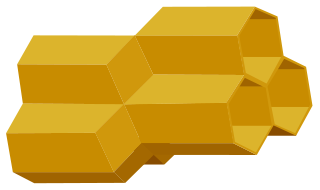
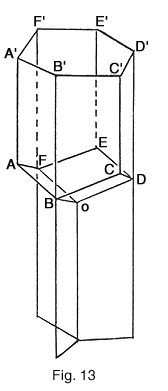
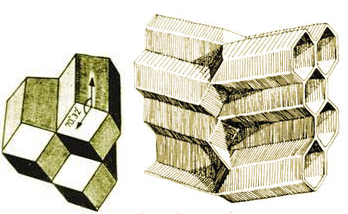
1. prepare different sizes of paper waxcells (lasercut), assemble maquette
2. 3D drawings and transfer to CadCam software for 3D-printing
3. 3D print with organic materials: sugar? else?
⇒ accompanied with exhibition Transparent Beehive + sound or Scaffolded Beehive + sound, + cabinet boxes Moebius+waxcomb.
beeswax
The word wax describes a large variety of substances of plant and animal origin, as well as man-made products, which are mostly petroleum derivatives. Natural waxes are not single substances, but a mixture of various long-chain fatty acids and a variety of other constituents, depending on their origin. Wax from the honeybee has an extremely wide spectrum of useful applications and occupies a very special position among waxes.
For centuries, beeswax was appreciated as the best material for making candles. The wrappings of Egyptian mummies contained beeswax and beeswax has long found use in medicinal practices and in creams and lotions. Of all the primary bee products it has been, and remains, the most versatile and most widely used material.
Physical characteristics of beeswax : Virgin beeswax, immediately after being secreted, elaborated and formed into comb, is white. It becomes darker with use inside the hive as pollen, silk and larval debris are inadvertently incorporated.
The melting point of beeswax is not constant since the composition varies slightly with its origin. Various pharmacopoeias give a range of 61-66C or more commonly, 62-65 C. Its relative density at 15 C is 0.958 – 0.970 g/cm3 and its electrical resistance ranges from 5×1012 to 20×1012 Ohm m. Its thermal conductivity coefficient is 2.5 x d10-3 Jcm/s°Ccm2. The saponification value of beeswax is 85-100.
Beeswax is an inert material with high plasticity at a relatively low temperature (around 32 C). Beeswax is also insoluble in water and resistant to many acids, but is soluble in most organic solvents such as ether, benzine, benzol, chloroform, and turpentine oil and after warming, in alcohol and fatty oils. Ghedda waxes from the Asian honeybee species are described as softer and more plastic. The melting point of wax from three Meliponid (stingless bee) species ranged between 64.6 and 66.5 C.
https://cleveland.ces.ncsu.edu/beeswax/
resources for preparing and studying pollen
http://www.microscopy-uk.org.uk/mag/indexmag.html?http://www.microscopy-uk.org.uk/mag/artjul99/pollen.html
http://www.microbehunter.com/making-mounts-of-pollen-grains/
pollen preparation
pollen analysis
The Maths of d'Arcy W. Thompson
Dive into: On Growth and Form.
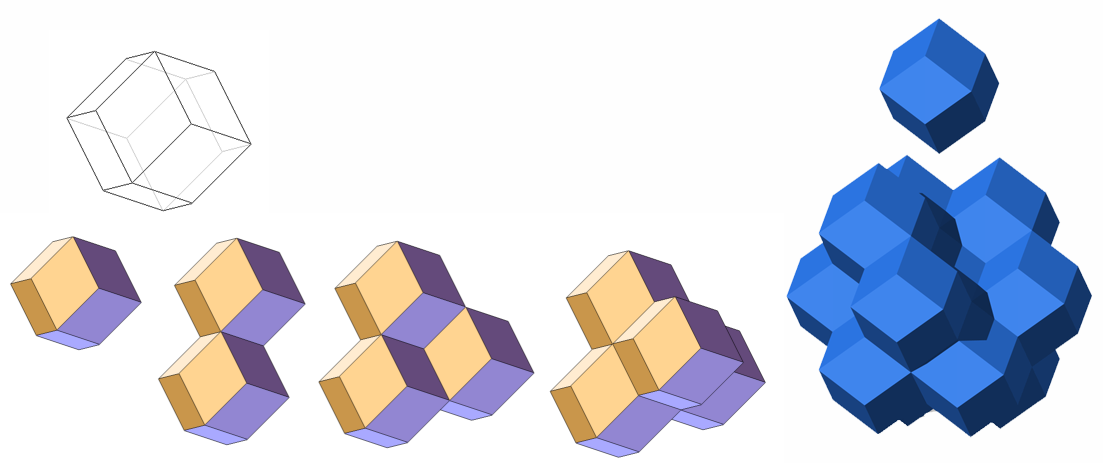
http://www.janthor.com/galerie10rho.html
http://en.wikipedia.org/wiki/Rhombic_dodecahedral_honeycomb
3D Wax Comb and Structures
A’B’C’D’E’F’ is the cell-mouth; A’A, B’B, etc., are the edges of the cell; ABOF, CDOB, EFOD are the three rhombs; O being the bottom of the cell. Let us now consider the other side of the comb. From O there starts a cell-edge similar to those at A’A, C’C, or E’E; so that the three rhombs each form part of the base of a different cell on the other side of the comb; A, C, and E being the bottom points of these three cells, and correspending to O in the first cell. The edges B’B, D’D, and F’F are continuous right through the comb from one side to the other; a point that is probably of importance in counecton with the well-known and hitherto unexplained ”pitch” of the cells.
http://www.beesource.com/point-of-view/ed-dee-lusby/historical-data-on-the-influence-of-cell-size/the-structure-of-comb-part-1/
The axes of honeycomb cells are always quasi-horizontal, and the nonangled rows of honeycomb cells are always horizontally (not vertically) aligned. Thus, each cell has two vertical walls, with “floors” and “ceilings” composed of two angled walls. The cells slope slightly upwards, between 9 and 14 degrees, towards the open ends. The hexagon tiles the plane with minimal surface area. Thus, a hexagonal structure uses the least material to create a lattice of cells within a given volume.
Honeycomb structures are natural or man-made structures that have the geometry of a honeycomb to allow the minimization of the amount of used material to reach minimal weight and minimal material cost.
http://en.wikipedia.org/wiki/Honeycomb_structure
http://www.nature.com/news/how-honeycombs-can-build-themselves-1.13398
chitin - chitosan
Darwin's Experiments
Honey-bees construct wax combs inside their nests. The combs are made of hexagonal prisms – cells – built back to back, and are used to store honey, nectar, and pollen, and to provide a nursery for bee larvae. The combs are natural engineering marvels, using the least possible amount of wax to provide the greatest amount of storage space, with the greatest possible structural stability. Darwin recognised that explaining the evolution of the honey-bee’s comb-building abilities was essential if his theory of natural selection was to be taken seriously, and in the 1850s he carried out his own experiments at his home at Down House in Kent, and wrote many letters on the subject.
http://www.darwinproject.ac.uk/the-evolution-of-honey-comb
Darwin on Bees
'I separated two combs and put them between a long, thick, rectangular strip of wax: the bees instantly began excavate minute circular pits in it; and as they deepened these little pits, they made them wider and wider until they were converted into shallow basins, appearing to the eye perfectly true or parts of a sphere, and of about the diameter of a cell...'
.
'I then put into the hive, instead of a thick rectangular piece of wax, a thin, narrow, knife-edged ridge, coloured with vermilion.[...] From the experiment of the ridge of vermilion wax we can see that [...] they could make their cells of the proper shape, by standing at the proper distance from each other, by excavating at the same rate, and by endeavouring to make equal spherical hollows, but never allowing the spheres to break into each other.
Cochineal and Ficus indica
The cochineal (Dactylopius coccus) is a scale insect in the suborder Sternorrhyncha, from which the crimson-coloured natural dye carmine is derived. This insect lives on cacti in the genus Opuntia, feeding on plant moisture and nutrients.
The insect produces carminic acid that deters predation by other insects. Carminic acid can be extracted from the body and eggs, then mixed with aluminium or calcium salts to make carmine dye. Carmine is today primarily used as a food colouring and for cosmetics.
http://en.wikipedia.org/wiki/Cochineal
The cochineals that I collected in la Gomera will serve to colour the bees wax for a remake of the Darwin experiment.

